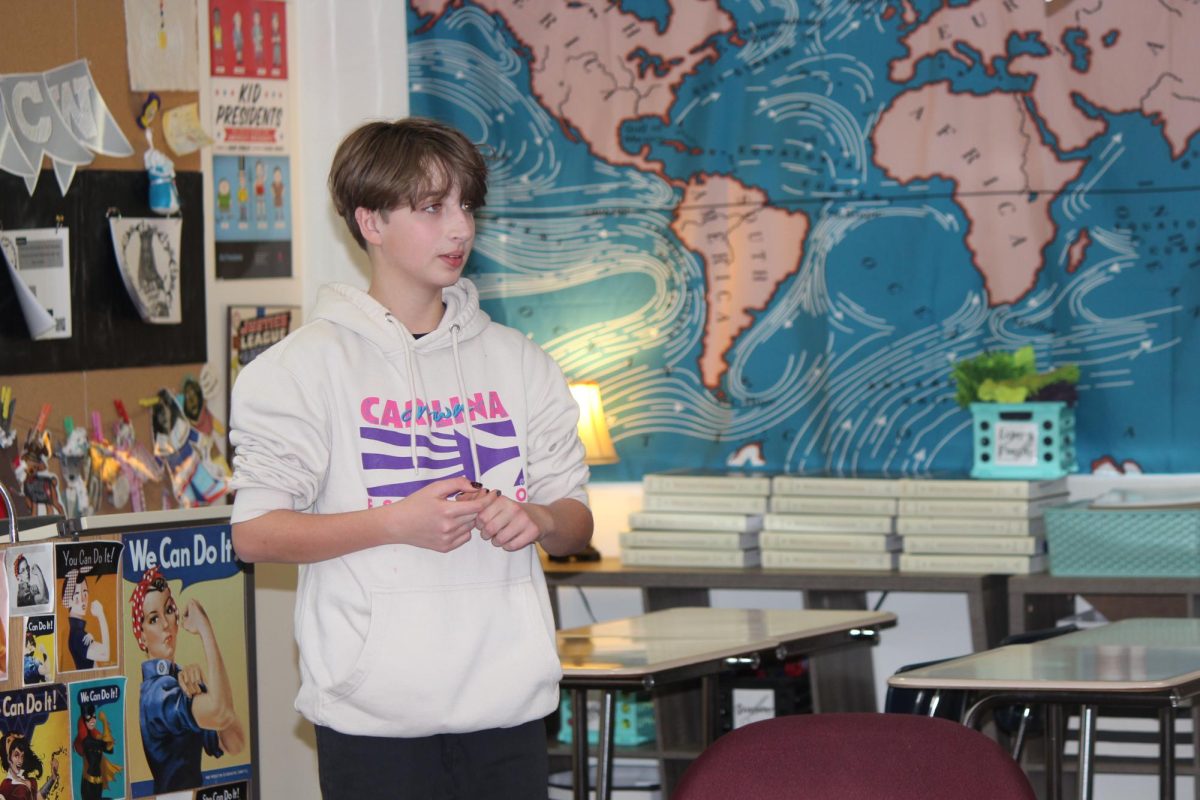Imagination and creativity are two traits often found within an artist. As he or she finishes the final stroke of a masterpiece, everyone is left wondering where the idea came from. While pure artistic intuition often plays a large role, the long-held tradition of gathering inspiration from other works has remained a critical part in the development of artistic genius.
According to Vivian Werstler, art student and junior, taking inspiration from other art is a frequent occurrence when people are developing new pieces.
She said, “It’s quite common that artists take inspiration from other artists or artwork. In a way, it’s almost flattering when someone takes a look at your art and creates something of their own just because they loved your work that much.”
Werstler also said inspiration is a technique that helps artists develop new ideas.
She said, “Just like writer’s block, artist’s block is a real thing too. During times when an artist just can’t seem to figure out what they want to create with their own imagination, they turn to artwork that isn’t their own for inspiration. Fortunately, there are hundreds of thousands of pieces that are accessible to the public which make it easier on the ones who need a little bit more than imagination.”

Junior Vivian Werstler adds to her drawing of a city street in SRT on May 9. Werstler said she found her own art by taking small pieces of inspiration from others’ work and combining them to create something unique to her.
According to art department chairperson Jennifer Bubp, looking to more professional and experienced artists for inspiration is a key step in the learning process.
“Typically, in every studio class we offer at Carmel, the first step when we roll out a concept or a theme for a project is that students go and research other artists who have explored that topic or theme for inspiration. That’s usually the starting point and then, as they get older and they start to develop their own body of work, we want them to have their own voice. But, even with that, students always begin with sources of inspiration from professional art,” she said. “I think it gives younger artists the imagination for what’s possible, whether it be for different media expressions, technical skills or just conceptually.”
Artist and sophomore Ana Veros said she agreed with Bubp that younger artists can get a better sense of what direction they would like to go in through inspiration.
“When you first start out…I don’t think you immediately know what you’re going to do, so finding inspiration from other artists isn’t just finding inspiration; it’s also teaching yourself,” she said. “You can look at how they do things and then you can decide what you think is the best or most efficient ways of doing things and learn those for yourself. As you do that, you notice that you can’t do it exactly the way they do, but you can do it in a way which fits your art; that’s when you start to reach your individuality in your art style.”
According to Bubp, while taking inspiration from other artists is a method for crafting a unique voice, it is important for these artists to make sure they are not simply stealing the work of another.
She said, “Traditional training for art education, for example back in Michelangelo’s day, is you would go and copy the master. You would literally become an apprentice to a professional artist before you would venture out on your own and we still hold value in that as a technique today…The goal is, though, as (art students) progress through the more advanced courses, they get away from copying photos and begin to develop their own voice…We try to teach them step-by-step of how to gravitate toward their own voice.”
Going beyond art, artists also tend to draw inspiration from other mediums, according to Veros, that may seem less conventional.
“Sometimes a song will give me a nice vibe and I’ll take that mood and transfer it into (my art),” she said. “I also like movies and TV shows, so when I see a nicely framed composition, I’ll reference that for a scene I want to draw. Cinematography is an art in and of itself and so it’s just another point you can draw inspiration from.”

With so many different and accessible avenues for inspiration, Bubp said it can become difficult to sift through it all to pick out precisely what it is an artist is looking for.
“When I was in high school in the 90s, we would go to the National Geographic magazines, tear photos out and that is what we would use. Now, you have anything you want at your fingertips with a cell phone,” she said. “There is so much out there for inspiration; I think the hard part now is narrowing the focus of, ‘How do I get across the idea in the most effective way?’”
With all this aside, taking inspiration is an instrumental piece in the development of an artist and in the progression of art as a whole, according to Werstler.
“Taking inspiration from others is normal and okay to do, as long as you credit the original artist,” she said. “Being inspired by different styles, media and colors is what makes my art unique. After all these years taking bits of many pieces of art and combining them to make something of my own, it’s almost as if I created a new style, a new scheme and it has made me realize that the artists’ works I took inspiration from were actually derived from the work of the people they looked up to. This is what makes art timeless.”





















































![Review: “Suits” is a perfect blend of legal drama and humor [MUSE]](https://hilite.org/wp-content/uploads/2024/04/unnamed-1.png)
![Chelsea Meng on her Instagram-run bracelet shop [Biz Buzz]](https://hilite.org/wp-content/uploads/2024/04/IMG_2446-1200x838.jpg)
![Review: Quiet on Set: The Dark Side of Kids TV is the long awaited exposé of pedophilia within the children’s entertainment industry [MUSE]](https://hilite.org/wp-content/uploads/2024/04/unnamed.jpg)
![Review: “The Iron Claw” cannot get enough praise [MUSE]](https://hilite.org/wp-content/uploads/2024/04/unnamed.png)
![Review: “The Bear” sets an unbelievably high bar for future comedy shows [MUSE]](https://hilite.org/wp-content/uploads/2024/03/unnamed.png)
![Review in Print: Maripaz Villar brings a delightfully unique style to the world of WEBTOON [MUSE]](https://hilite.org/wp-content/uploads/2023/12/maripazcover-1200x960.jpg)
![Review: “The Sword of Kaigen” is a masterpiece [MUSE]](https://hilite.org/wp-content/uploads/2023/11/Screenshot-2023-11-26-201051.png)
![Review: Gateron Oil Kings, great linear switches, okay price [MUSE]](https://hilite.org/wp-content/uploads/2023/11/Screenshot-2023-11-26-200553.png)
![Review: “A Haunting in Venice” is a significant improvement from other Agatha Christie adaptations [MUSE]](https://hilite.org/wp-content/uploads/2023/11/e7ee2938a6d422669771bce6d8088521.jpg)
![Review: A Thanksgiving story from elementary school, still just as interesting [MUSE]](https://hilite.org/wp-content/uploads/2023/11/Screenshot-2023-11-26-195514-987x1200.png)
![Review: When I Fly Towards You, cute, uplifting youth drama [MUSE]](https://hilite.org/wp-content/uploads/2023/09/When-I-Fly-Towards-You-Chinese-drama.png)
![Postcards from Muse: Hawaii Travel Diary [MUSE]](https://hilite.org/wp-content/uploads/2023/09/My-project-1-1200x1200.jpg)
![Review: Ladybug & Cat Noir: The Movie, departure from original show [MUSE]](https://hilite.org/wp-content/uploads/2023/09/Ladybug__Cat_Noir_-_The_Movie_poster.jpg)
![Review in Print: Hidden Love is the cute, uplifting drama everyone needs [MUSE]](https://hilite.org/wp-content/uploads/2023/09/hiddenlovecover-e1693597208225-1030x1200.png)
![Review in Print: Heartstopper is the heartwarming queer romance we all need [MUSE]](https://hilite.org/wp-content/uploads/2023/08/museheartstoppercover-1200x654.png)























![Review: Ladybug & Cat Noir: The Movie, departure from original show [MUSE]](https://hilite.org/wp-content/uploads/2023/09/Ladybug__Cat_Noir_-_The_Movie_poster-221x300.jpg)

![Review: Next in Fashion season two survives changes, becomes a valuable pop culture artifact [MUSE]](https://hilite.org/wp-content/uploads/2023/03/Screen-Shot-2023-03-09-at-11.05.05-AM-300x214.png)
![Review: Is The Stormlight Archive worth it? [MUSE]](https://hilite.org/wp-content/uploads/2023/10/unnamed-1-184x300.png)




